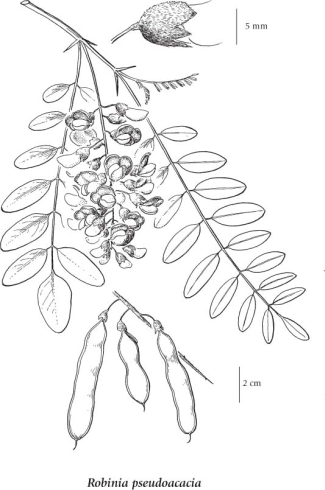black locust
Fabaceae (Pea family)
Introduction to Vascular Plants
Introduction
Black locust is deciduous weedy tree species in the Pea Family (Fabacaea). It is native to the southeastern United States but has been introduced across the US and parts of Canada where it has been used both ornamentally and in land reclamation (USDA 2010). In BC, it has escaped and naturalized in the southern part of the province in disturbed areas and forest edges. It is a tall (to 25 m), nearly glabrous, deciduous tree that reaches heights of 80 ft. It has dark-brown, deeply furrowed bark and prickly branches with alternate, large, and pinnate leaves that have (7) 11 to 21 leaflets. The white flowers are very fragrant, producing drooping, smooth, shiny pea pods that contain 4 to 8 seeds and remain on the branches in winter. It reproduces from seeds, suckers, and stump sprouts and can form thickets (Global Invasive Species Database 2010). Across its range, it is particularly invasive in "dry and sand prairies and oak savannas" (Global Invasive Species Database 2010).
View more photos of this species.
|
Species Information
General:
Fast-growing, spiny tree with thick, furrowed bark, to 25 m tall, often spreading by underground suckers.
Leaves:
Alternate, deciduous, stalked, pinnately compound; leaflets 11 to 21, paired, lanceolate to elliptic-oval, 2-4 cm long, bright green on the upper surface, pale beneath; stipules modified into spines.
Flowers:
Inflorescence a stalked, axillary, drooping raceme 10-14 cm long, of 30 to 70 fragrant, pea-like flowers; corollas white, 14-20 mm long, the banner yellow-blotched at the base; calyces bell-shaped, 5-6 mm long, densely hairy.
Fruits:
Pods, oblong, flattened, 6-12 cm long, drooping, glabrous, becoming papery and darkening with age, persistent through winter.
Illustration

If more than one illustration is available for a species (e.g., separate illustrations were provided for two subspecies) then links to the separate images will be provided below. Note that individual subspecies or varietal illustrations are not always available.
Illustration Source: The Illustrated Flora of British Columbia
USDA Species Characteristics
Flower Colour:
White
Blooming Period:
Spring
Fruit/Seed characteristics:
Colour: Black
Present from Spring to Summer
Source: The USDA
Habitat and Range
Mesic disturbed areas and forest edges; rare horticultural escape in SW and SC BC; native to E U.S.Status Information
Synonyms
Synonyms and Alternate Names:
Robinia pseudoacacia (Mirb.) Rehder
Robinia pseudoacacia var. pyramidalis Pepin
Robinia pseudoacacia var. rectissima (L.) Raber
References
Global Invasive Species Database. 2010. Robinia pseudoacacia. Compiled by the National Biological Information Infrastructure (NBII) & IUCN/SSC Invasive Species Specialist Group (ISSG).
Stone, Katharine R. 2009. Robinia pseudoacacia. In: Fire Effects Information System. U.S. Department of Agriculture, Forest Service, Rocky Mountain Research Station, Fire Sciences Laboratory. Available Online.
USDA. 2010. Plant profile for Robinia pseudoacacia. USDA Plants Database. United States Department of Agriculture. Available Online.